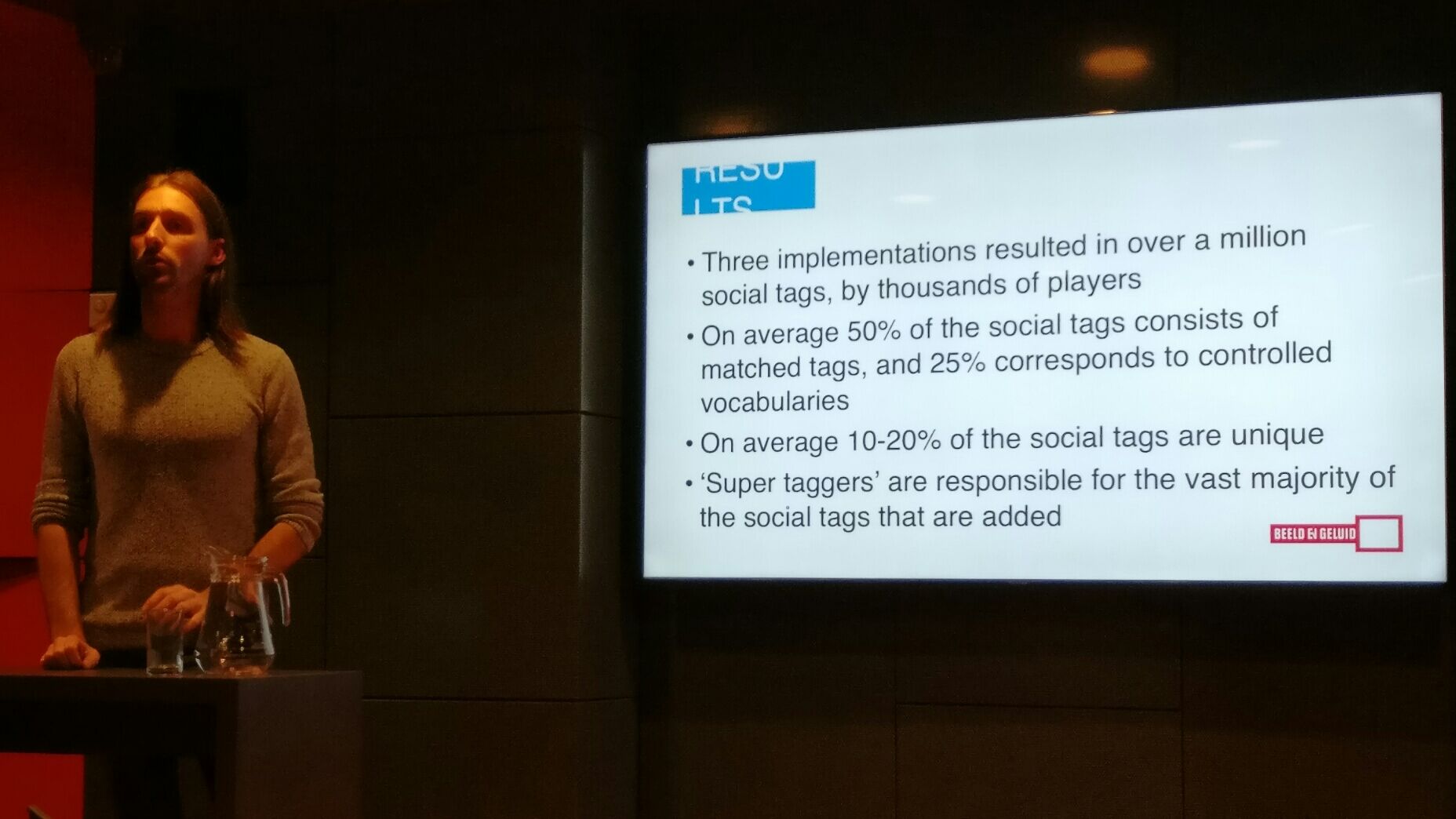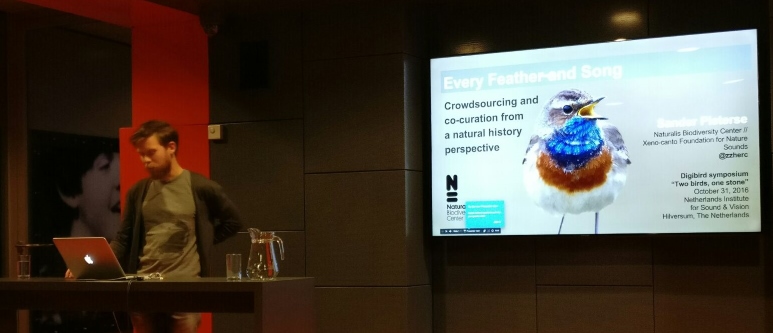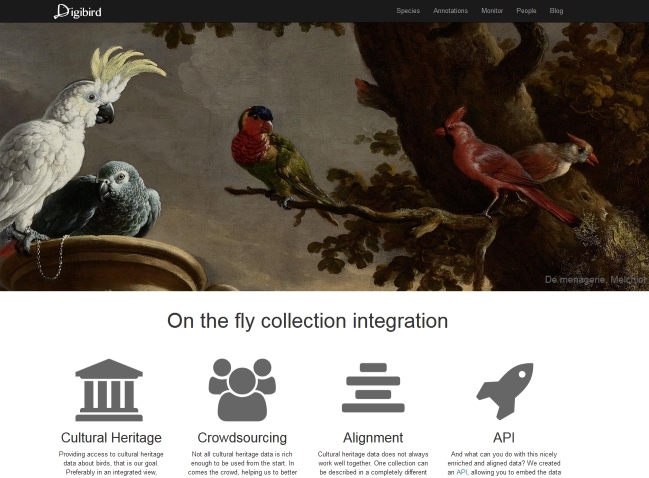Crowdsourcing has been described as a way to "outsource work to the crowd" (see full definition). For instance, a broad audience can help in the transcription of manuscripts, or even to classify the galaxy. This idea is not just useful in a research context, but also for libraries, museums and archives. To see whether this would also be valuable for the visual navigation project and our library, we attended a workshop in the Netherlands centered around this topic.
Video tagging
 The first presentation in the workshop discussed Waisda (waisda.beeldengeluid.nl), a video tagging game for audiovisual heritage collections, and how to utilize the “cognitive surplus” of website visitors for enriching and annotating heritage collections. Learned lessons from three video crowdsourcing projects include the importance of aiming for attracting niches (not the general public), of using open knowledge structures, and that it is essential to accept and respect multiple authorities and perspectives with respect to an institution’s own collection.
The first presentation in the workshop discussed Waisda (waisda.beeldengeluid.nl), a video tagging game for audiovisual heritage collections, and how to utilize the “cognitive surplus” of website visitors for enriching and annotating heritage collections. Learned lessons from three video crowdsourcing projects include the importance of aiming for attracting niches (not the general public), of using open knowledge structures, and that it is essential to accept and respect multiple authorities and perspectives with respect to an institution’s own collection.
Crowdsourcing natural history and art collections
 A second presentation discussed “Crowdsourcing and Co-curation from a Natural History Perspective”, and introduced nederlandsesoorten.nl (a species thesaurus), a crowdsourcing “specimen label transcription” project (via velehanden.nl), and xeno-canto, a world-wide collaborative bird sound database. Learned lessons emphasized the importance of providing a shared goal for the users (“solve puzzles together”), to allowing for autonomy and mastery (e.g. customized personal user pages). But also content issues arose when doing crowdsourcing (disagreements between users, and copyright problems). Available expertise, and a lack thereof, may also be a bottleneck.
A second presentation discussed “Crowdsourcing and Co-curation from a Natural History Perspective”, and introduced nederlandsesoorten.nl (a species thesaurus), a crowdsourcing “specimen label transcription” project (via velehanden.nl), and xeno-canto, a world-wide collaborative bird sound database. Learned lessons emphasized the importance of providing a shared goal for the users (“solve puzzles together”), to allowing for autonomy and mastery (e.g. customized personal user pages). But also content issues arose when doing crowdsourcing (disagreements between users, and copyright problems). Available expertise, and a lack thereof, may also be a bottleneck.
The Rijksmuseum, the most visited museum in the Netherlands, discussed the crowdsourcing of their large online collection (e.g. they provide 274,000 hires images). Structured crowdsourcing is done via the Accurator toolset, aiming for specific niches. Based on crowdsourcing projects conducted in the Rijksmuseum, the speaker discussed the a number of issues that may arise in an institutional context, such as the consolidation of previous research results, the ingestion of elicited metadata in the collection, infrastructure management, and data modeling.
Towards a "hub" for crowdsourcing projects
 Finally, the DigiBird project was presented. In the presentation, some of the issues with crowdsourcing were shown, such as the necessity to continuously promote crowdsourcing as an organization, and the unreliability of the voluntary contributors involved in crowdsourcing. Digibird aims at “on the fly collection integration using crowdsourcing”, and to create “hub” between projects using shared vocabularies as a bridge, to decrease the scattered nature of crowdsourcing projects and data. It also allows for integrated searching in different crowdsourced bird-related audiovisual collections (e.g. for a specific bird). Using the system, institutions are able to monitor their crowdsourcing progress dynamically, getting a better overview of their progress. By means of these initiatives, crowdsourcing may become more useful in institutional settings at large.
Finally, the DigiBird project was presented. In the presentation, some of the issues with crowdsourcing were shown, such as the necessity to continuously promote crowdsourcing as an organization, and the unreliability of the voluntary contributors involved in crowdsourcing. Digibird aims at “on the fly collection integration using crowdsourcing”, and to create “hub” between projects using shared vocabularies as a bridge, to decrease the scattered nature of crowdsourcing projects and data. It also allows for integrated searching in different crowdsourced bird-related audiovisual collections (e.g. for a specific bird). Using the system, institutions are able to monitor their crowdsourcing progress dynamically, getting a better overview of their progress. By means of these initiatives, crowdsourcing may become more useful in institutional settings at large.
A full report can be available here. Presentations and streams of the workshop can be found via SlideShare.
Logg inn for å kommentere
Ikke UiO- eller Feide-bruker?
Opprett en WebID-bruker for å kommentere